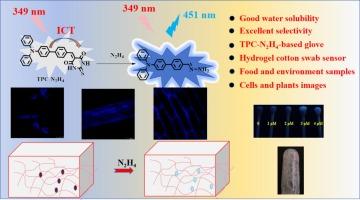设计一种荧光探针,用于可视和可穿戴式检测食品、环境样本和生物成像中的 N2H4。
IF 4.3
2区 化学
Q1 SPECTROSCOPY
Spectrochimica Acta Part A: Molecular and Biomolecular Spectroscopy
Pub Date : 2024-11-03
DOI:10.1016/j.saa.2024.125365
引用次数: 0
摘要
肼(N2H4)作为一种重要的化工原料被广泛应用于多个领域,对人类、食品和环境造成了严重危害。因此,本研究利用分子内电荷转移(ICT)过程制备了一种智能荧光探针 TPC-N2H4,用于对多种样品中的 N2H4 进行比色和荧光分辨。当 TPC-N2H4 遇到 N2H4 时,在 451 纳米波长处明显观察到蓝色发射,这是因为 ICT 过程中断,形成了腙结构。此外,还开发了用于实时监测 N2H4 的智能手机辅助比色和荧光传感平台。重要的是,毒性低的 TPC-N2H4 显示了其在 HeLa 细胞、洋葱和拟南芥中成像 N2H4 的能力。有趣的是,以 TPC-N2H4 为识别单元开发的水凝胶涂层棉签传感器在 N2H4 熏蒸后显示出明显的颜色和发射变化,且响应速度快。构建了可穿戴的柔性荧光 TPC-N2H4 手套,用于监测食品和环境样品中的 N2H4。简而言之,TPC-N2H4 探针不仅在环境和食品安全的 N2H4 检测中显示出巨大潜力,而且为有毒物质检测中的可穿戴追踪平台提供了一种新方法。本文章由计算机程序翻译,如有差异,请以英文原文为准。

Engineering a fluorescent probe for the visual and wearable detection of N2H4 in foods, environment samples and biological imaging
Hydrazine (N2H4), as an important chemical raw material widely used in many fields, caused serious harm to human, food and environment. Therefore, a smart fluorescent probe TPC-N2H4 with intramolecular charge transfer (ICT) process was fabricated for colorimetric and fluorescent differentiating of N2H4 in many samples. When TPC-N2H4 met N2H4, blue emission at 451 nm was obviously observed attributed to the interruption of ICT process, resulting in the formation of the hydrazone structure. Additionally, smartphone-assisted colorimetric and fluorescent sensing platforms had been developed for real-time monitoring of N2H4. Importantly, TPC-N2H4 with low toxicity revealed its ability to image N2H4 in HeLa cells, onion and Arabidopsis thaliana. Interestingly, a hydrogel-coated cotton swab sensor was developed with TPC-N2H4 as recognition unit, which showed obvious color and emission changes after N2H4 fumigation with fast response speed. Flexible fluorescent TPC-N2H4-glove was constructed for wearable N2H4 detection and used to monitor N2H4 in food and environment samples. In brief, the TPC-N2H4 probe not only showed great potential in N2H4 detection for environmental and food safety, but also provided a new method for wearable tracking platforms in toxic substance detection.
求助全文
通过发布文献求助,成功后即可免费获取论文全文。
去求助
来源期刊
CiteScore
8.40
自引率
11.40%
发文量
1364
审稿时长
40 days
期刊介绍:
Spectrochimica Acta, Part A: Molecular and Biomolecular Spectroscopy (SAA) is an interdisciplinary journal which spans from basic to applied aspects of optical spectroscopy in chemistry, medicine, biology, and materials science.
The journal publishes original scientific papers that feature high-quality spectroscopic data and analysis. From the broad range of optical spectroscopies, the emphasis is on electronic, vibrational or rotational spectra of molecules, rather than on spectroscopy based on magnetic moments.
Criteria for publication in SAA are novelty, uniqueness, and outstanding quality. Routine applications of spectroscopic techniques and computational methods are not appropriate.
Topics of particular interest of Spectrochimica Acta Part A include, but are not limited to:
Spectroscopy and dynamics of bioanalytical, biomedical, environmental, and atmospheric sciences,
Novel experimental techniques or instrumentation for molecular spectroscopy,
Novel theoretical and computational methods,
Novel applications in photochemistry and photobiology,
Novel interpretational approaches as well as advances in data analysis based on electronic or vibrational spectroscopy.

 求助内容:
求助内容: 应助结果提醒方式:
应助结果提醒方式:


